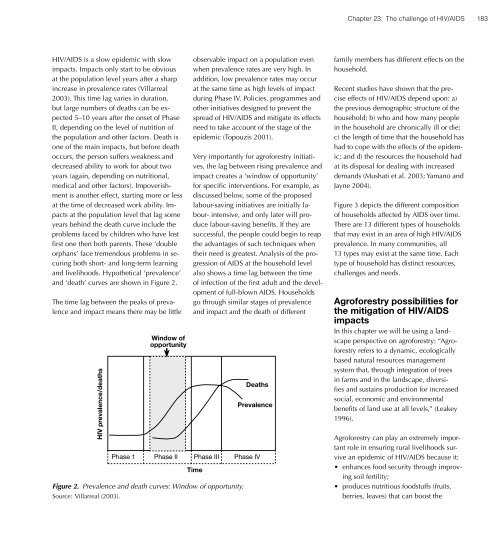The challenge of HIV/AIDS: Where does agroforestry fit in? - World ...
The challenge of HIV/AIDS: Where does agroforestry fit in? - World ...
The challenge of HIV/AIDS: Where does agroforestry fit in? - World ...
Create successful ePaper yourself
Turn your PDF publications into a flip-book with our unique Google optimized e-Paper software.
Chapter 23: <strong>The</strong> <strong>challenge</strong> <strong>of</strong> <strong>HIV</strong>/<strong>AIDS</strong>183<strong>HIV</strong>/<strong>AIDS</strong> is a slow epidemic with slowimpacts. Impacts only start to be obviousat the population level years after a sharp<strong>in</strong>crease <strong>in</strong> prevalence rates (Villarreal2003). This time lag varies <strong>in</strong> duration,but large numbers <strong>of</strong> deaths can be expected5–10 years after the onset <strong>of</strong> PhaseII, depend<strong>in</strong>g on the level <strong>of</strong> nutrition <strong>of</strong>the population and other factors. Death isone <strong>of</strong> the ma<strong>in</strong> impacts, but before deathoccurs, the person suffers weakness anddecreased ability to work for about twoyears (aga<strong>in</strong>, depend<strong>in</strong>g on nutritional,medical and other factors). Impoverishmentis another effect, start<strong>in</strong>g more or lessat the time <strong>of</strong> decreased work ability. Impactsat the population level that lag someyears beh<strong>in</strong>d the death curve <strong>in</strong>clude theproblems faced by children who have lostfirst one then both parents. <strong>The</strong>se ‘doubleorphans’ face tremendous problems <strong>in</strong> secur<strong>in</strong>gboth short- and long-term learn<strong>in</strong>gand livelihoods. Hypothetical ‘prevalence’and ‘death’ curves are shown <strong>in</strong> Figure 2.<strong>The</strong> time lag between the peaks <strong>of</strong> prevalenceand impact means there may be little<strong>HIV</strong> prevalence/deathsFigure 2. Prevalence and death curves: W<strong>in</strong>dow <strong>of</strong> opportunity.Source: Villarreal (2003).W<strong>in</strong>dow <strong>of</strong>opportunityHigh <strong>HIV</strong> rates/low impactobservable impact on a population evenwhen prevalence rates are very high. Inaddition, low prevalence rates may occurat the same time as high levels <strong>of</strong> impactdur<strong>in</strong>g Phase IV. Policies, programmes andother <strong>in</strong>itiatives designed to prevent thespread <strong>of</strong> <strong>HIV</strong>/<strong>AIDS</strong> and mitigate its effectsneed to take account <strong>of</strong> the stage <strong>of</strong> theepidemic (Topouzis 2001).Very importantly for agr<strong>of</strong>orestry <strong>in</strong>itiatives,the lag between ris<strong>in</strong>g prevalence andimpact creates a ‘w<strong>in</strong>dow <strong>of</strong> opportunity’for specific <strong>in</strong>terventions. For example, asdiscussed below, some <strong>of</strong> the proposedlabour-sav<strong>in</strong>g <strong>in</strong>itiatives are <strong>in</strong>itially labour-<strong>in</strong>tensive, and only later will producelabour-sav<strong>in</strong>g bene<strong>fit</strong>s. If they aresuccessful, the people could beg<strong>in</strong> to reapthe advantages <strong>of</strong> such techniques whentheir need is greatest. Analysis <strong>of</strong> the progression<strong>of</strong> <strong>AIDS</strong> at the household levelalso shows a time lag between the time<strong>of</strong> <strong>in</strong>fection <strong>of</strong> the first adult and the development<strong>of</strong> full-blown <strong>AIDS</strong>. Householdsgo through similar stages <strong>of</strong> prevalenceand impact and the death <strong>of</strong> differentPhase 1 Phase II Phase III Phase IVTimeDeathsPrevalencefamily members has different effects on thehousehold.Recent studies have shown that the preciseeffects <strong>of</strong> <strong>HIV</strong>/<strong>AIDS</strong> depend upon: a)the previous demographic structure <strong>of</strong> thehousehold; b) who and how many people<strong>in</strong> the household are chronically ill or die;c) the length <strong>of</strong> time that the household hashad to cope with the effects <strong>of</strong> the epidemic;and d) the resources the household hadat its disposal for deal<strong>in</strong>g with <strong>in</strong>creaseddemands (Mushati et al. 2003; Yamano andJayne 2004).Figure 3 depicts the different composition<strong>of</strong> households affected by <strong>AIDS</strong> over time.<strong>The</strong>re are 13 different types <strong>of</strong> householdsthat may exist <strong>in</strong> an area <strong>of</strong> high <strong>HIV</strong>/<strong>AIDS</strong>prevalence. In many communities, all13 types may exist at the same time. Eachtype <strong>of</strong> household has dist<strong>in</strong>ct resources,<strong>challenge</strong>s and needs.Agr<strong>of</strong>orestry possibilities forthe mitigation <strong>of</strong> <strong>HIV</strong>/<strong>AIDS</strong>impactsIn this chapter we will be us<strong>in</strong>g a landscapeperspective on agr<strong>of</strong>orestry: “Agr<strong>of</strong>orestryrefers to a dynamic, ecologicallybased natural resources managementsystem that, through <strong>in</strong>tegration <strong>of</strong> trees<strong>in</strong> farms and <strong>in</strong> the landscape, diversifiesand susta<strong>in</strong>s production for <strong>in</strong>creasedsocial, economic and environmentalbene<strong>fit</strong>s <strong>of</strong> land use at all levels,” (Leakey1996).Agr<strong>of</strong>orestry can play an extremely importantrole <strong>in</strong> ensur<strong>in</strong>g rural livelihoods survivean epidemic <strong>of</strong> <strong>HIV</strong>/<strong>AIDS</strong> because it:• enhances food security through improv<strong>in</strong>gsoil fertility;• produces nutritious foodstuffs (fruits,berries, leaves) that can boost the




![MNC_00_Modau [Compatibility Mode].pdf](https://img.yumpu.com/51432208/1/190x146/mnc-00-modau-compatibility-modepdf.jpg?quality=85)











